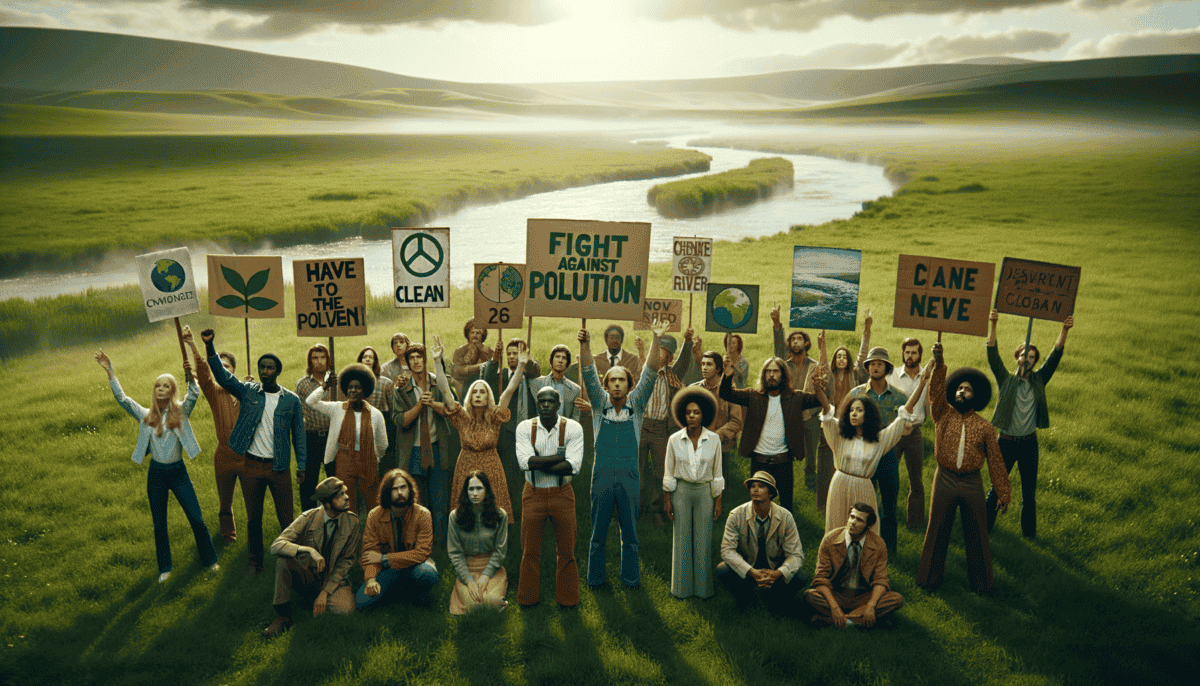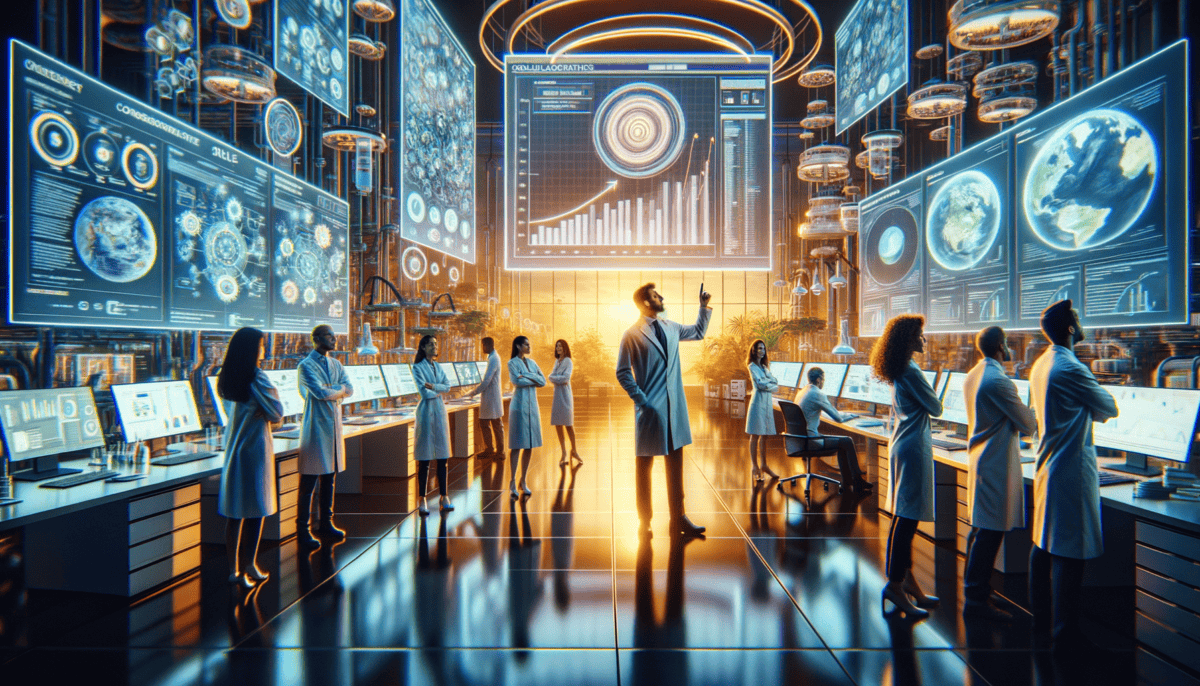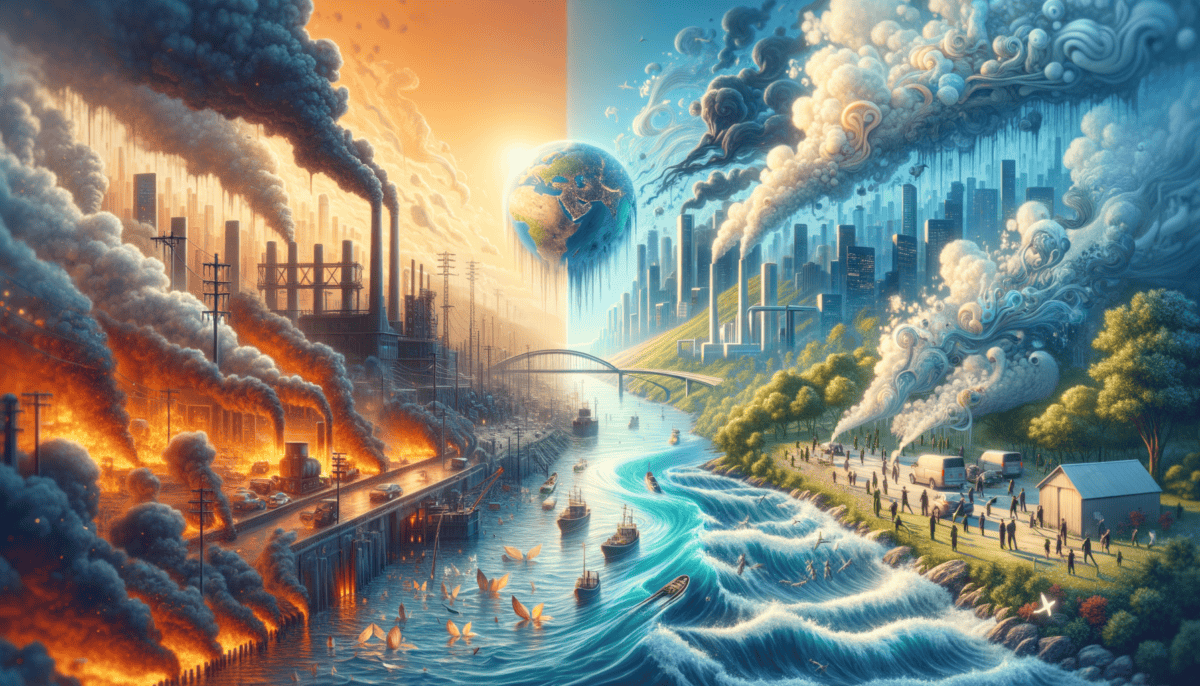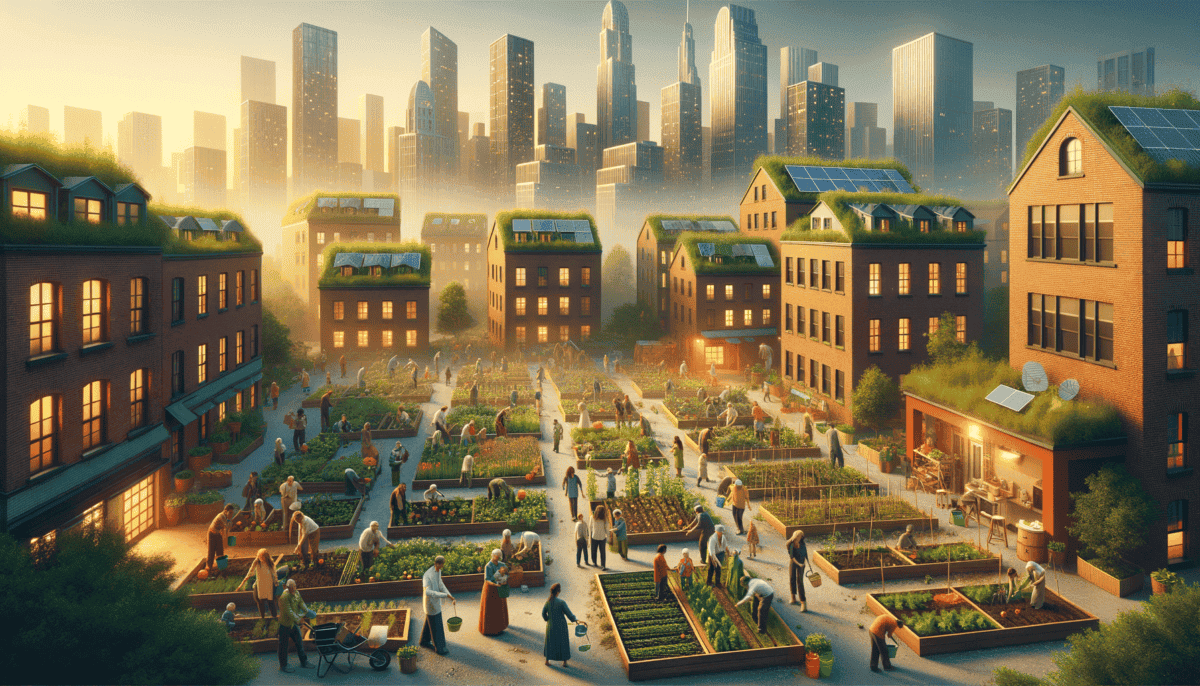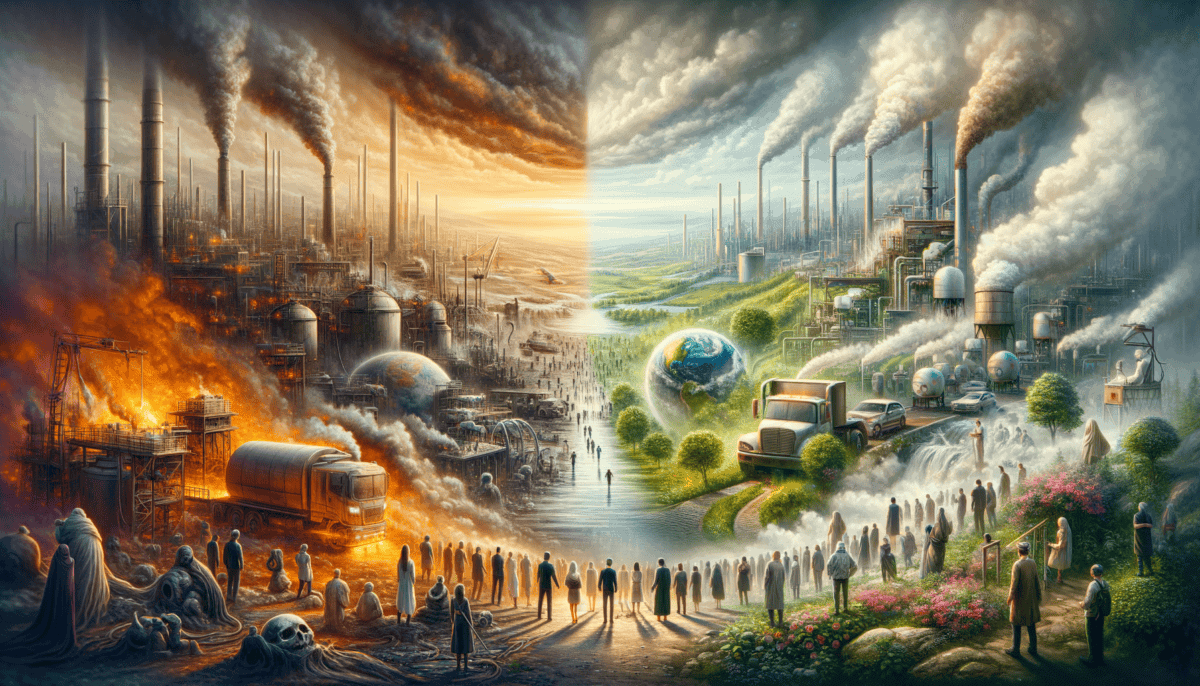The Smoky Beginning
Lucy peered through her bedroom window at the gray clouds billowing from the factory chimneys nearby. It wasn't a stormy day – these clouds were different. They were the smoke clouds that had become a regular part of her city's skyline in 1910.
"Papa, why is the sky always so dark now?" she asked her father, who was busy writing in his notebook. Dr. James Thompson looked up from his work, his eyes crinkling with concern behind his round spectacles.
"That's what I'm studying, my dear," he replied, adjusting his white lab coat. "Those clouds aren't like regular clouds. They come from the factories where people make things like cars and clothes."
Lucy wrinkled her nose. "But they make the air smell funny."
Outside their window, horses pulled carriages through the streets, but more and more motor cars were appearing each day. The factories grew bigger and bigger to make these new machines. Each one added more smoke to the sky.
"Look at this," Dr. Thompson said, showing Lucy a leaf from a plant on their windowsill. The leaf had turned brown and spotty. "The smoke is making it hard for plants to grow healthy and strong."
Lucy touched the leaf gently. "Can we help the plants, Papa?"
Her father smiled and pulled out his notebook. "That's exactly what I'm trying to figure out. See these notes? I'm writing down everything I notice about how the smoke affects our city."
The air grew thicker as more factories opened. Birds that used to visit their garden became rare visitors. The white sheets Mother hung out to dry turned gray before they could even dry properly.
One morning, Lucy woke up to find her father excitedly packing his equipment. "What's happening, Papa?"
"I've been invited to a special meeting," he beamed. "Other scientists have noticed the same problems in their cities. We're going to work together to understand what's happening to our air, water, and land."
"Will you fix it?" Lucy asked hopefully.
Dr. Thompson knelt beside her. "It won't be easy, and it won't happen quickly. But this is the beginning of something important. People are starting to realize we need to take care of our Earth."
"I want to help too!" Lucy declared, picking up her father's spare notebook.
"That's my girl," he smiled, handing her a pencil. "Remember what we see today – you're watching history happen. Someday, people will look back and remember this time as when we first started to understand how important clean air and water are."
Through her window, Lucy watched a new factory being built. But instead of feeling sad, she opened her notebook and started writing, just like her father. She didn't know it yet, but she was about to witness the beginning of a long battle – the fight against pollution that would change the world forever.
“Sometimes,” her father told her, “the biggest changes start when one person notices something isn’t right and decides to do something about it.”
That night, Lucy drew a picture in her notebook: a city with clear skies and healthy plants. Below it, she wrote in her best handwriting: "One day, we'll make it better."
The Great Awakening
The year was 1962, and Rachel Carson’s living room was filled with letters. Each envelope contained stories from people worried about their environment. Rachel picked up one letter from a mother in Ohio.
“Dear Ms. Carson,” she read aloud. “The river near our house used to be clean and full of fish. Now it’s different. The water looks strange, and we can’t swim there anymore.”
Rachel looked out her window at the birds flying by. She remembered how many more birds there used to be. Something was making them disappear. She knew she had to tell everyone about what was happening to our Earth.
“The truth needs to be shared,” she said to her cat, Moppet, who sat purring on her desk. Rachel began typing her book, “Silent Spring.”
Meanwhile, across the country, something terrible happened. The Cuyahoga River in Cleveland caught fire! Yes, a river actually burned because it was so polluted. People couldn’t believe their eyes.
“How can a river burn?” asked Jimmy, a local boy watching from the bridge. “Rivers are supposed to be full of water!”
His father shook his head. “The river is full of oil and chemicals from the factories, son. That’s what’s burning.”
The burning river made news everywhere. People started to wake up. They realized pollution wasn’t just ugly – it was dangerous!
In California, a group of students gathered on their school playground. Their teacher, Ms. Martinez, had brought them outside for a special lesson.
“Look at these pictures,” she said, showing them photos from different years. “This is our town in 1920, 1940, and today in 1970. What differences do you see?”
The children noticed how the clear blue skies had turned brown. They saw how the beautiful forest had become smaller as more buildings appeared.
Little Sarah raised her hand. “Can we fix it, Ms. Martinez?”
“Yes, we can!” Ms. Martinez smiled. “That’s why people are joining together to help. They’re called environmentalists.”
Here’s what the environmentalists fought for:
• Clean air to breathe
• Clean water to drink
• Safe places for animals to live
• Healthy soil for growing food
• Protected forests and oceans
All across America, people started speaking up. They wore buttons that said “Save Our Earth” and carried signs at marches. Children planted trees at their schools. Scientists studied ways to make factories cleaner.
One day, a senator named Gaylord Nelson had a big idea. “Let’s have a special day to teach everyone about taking care of Earth,” he suggested. This became the first Earth Day in 1970!
Twenty million people joined the first Earth Day celebration. They cleaned up parks, learned about nature, and promised to help protect our planet.
Back in her study, Rachel Carson smiled as she watched the news about Earth Day on TV. Her book had helped start something amazing. More and more people were joining the fight against pollution.
“Look, Moppet,” she said to her cat. “People are finally waking up. They’re learning that we need to protect our beautiful Earth.”
The movement was growing stronger every day. New laws were being made to stop pollution. Companies had to find cleaner ways to make things. People learned that everyone – grown-ups and kids alike – could help make the world cleaner and healthier.
That night, thousands of people across the country looked up at the same stars, thinking about how they could help save their planet. The great awakening had begun, and there was no turning back.
The Science Solution
Dr. Maya Chen stood in her bright laboratory, looking at a strange plant growing in a special container. The plant was doing something amazing – it was cleaning dirty water!
“Look at this!” she called to her young assistant, Tommy. “The water is getting clearer every day!”
Tommy peered into the container. “Wow! How does it work, Dr. Chen?”
“The plant’s roots suck up the bad stuff, just like you drink juice through a straw,” she explained with a smile. “Nature is very smart!”
Across town, another scientist named Dr. James Wilson was working on something exciting too. He had built a special machine that could catch the smoke from factory chimneys before it made the air dirty.
“If we can trap the yucky stuff before it gets into the air,” he told his daughter Lisa, “we can keep our skies blue!”
Lisa watched as her dad showed her a model of his invention. “It’s like a giant vacuum cleaner for the sky!” she giggled.
Meanwhile, in a sunny field, Sarah Martinez (who was now grown up and a scientist herself) was testing new solar panels. These panels could turn sunlight into electricity without making any pollution!
The future was looking brighter as scientists found new ways to make clean energy from the sun, wind, and water.
Here are some of the amazing things scientists invented to fight pollution:
• Solar panels for clean electricity
• Filters to clean factory smoke
• Special plants to clean dirty water
• Cars that run on electricity
• Ways to turn trash into new things
One morning, all these scientists got together for a big meeting. They shared their ideas and discoveries with each other.
“Together, we can solve the pollution problem!” Dr. Chen announced. Everyone clapped and cheered.
Back in her lab, Dr. Chen got an exciting phone call. A big factory wanted to use her special plants to clean their water!
“This is wonderful news,” she told Tommy. “Our plants will help keep rivers clean for fish and people!”
Dr. Wilson’s smoke-catching machines were being installed in factories too. The air in cities started getting cleaner. People could see the mountains again on clear days!
Sarah’s solar panels were going up on roofs everywhere. “Look how many houses are using the sun’s power now,” she told her old teacher, Ms. Martinez, who came to visit.
Kids at schools started learning about these new inventions. They built their own mini solar cars and grew plants that could clean water.
One little girl named Maria raised her hand during science class. “When I grow up, I want to be a scientist like Dr. Chen and help save the Earth!”
Her teacher smiled. “That’s wonderful! We need more scientists to keep finding new ways to fight pollution.”
That evening, as the sun set, Dr. Chen looked out her laboratory window. She could see solar panels gleaming on rooftops and factory chimneys with their new filters working hard. The river nearby was getting cleaner thanks to her special plants.
She wrote in her journal: “Today was a good day for science. Tomorrow will be even better!” ⭐
Working Together for Change
The big meeting room was packed with important people from all around the world. They were there to talk about how to make Earth cleaner.
“We must work together to save our planet,” said Maria Santos, who spoke for her country. She showed pictures of dirty rivers and smoky skies. “Look at what pollution does to our home.”
Everyone in the room nodded. They knew it was time to make big changes.
John Chen, Dr. Chen’s brother who worked for the government, stood up to speak. “My sister showed us that plants can clean water. Now we need rules to make sure factories use these good ideas.”
“Every country must do their part,” he said. “The Earth belongs to all of us!”
Back home, cities started making new rules too. Mayor Thompson called a special meeting at City Hall.
“Starting next month, all our buses will run on clean electricity,” she announced with a big smile. “No more smoky buses!”
The children in Ms. Martinez’s class cheered when they heard the news. They had written letters to the mayor asking for cleaner buses.
Even big companies started to help. They promised to use clean energy and stop making so much pollution.
Here are some of the new rules that helped fight pollution:
• Cars must be cleaner
• Factories must use filters
• More solar and wind power
• Less plastic waste
• Better recycling
Sarah Martinez was now helping companies switch to solar power. “Look how many businesses want clean energy now!” she told her team. ☀️
At the airport, planes started using cleaner fuel. “These new rules help us fly without making so much pollution,” the pilot told his passengers.
In parks, workers planted more trees to help clean the air. “Each tree is like a tiny helper,” the park ranger explained to visiting kids.
Dr. Wilson visited schools to talk about his smoke-catching machines. “The new rules say factories must use filters like mine,” he told the students. “That means cleaner air for everyone!”
One day, Lisa (Dr. Wilson’s daughter) saw a rainbow in the sky. “Look, Dad! The air is so clean now, we can see beautiful rainbows again!”
Maria Santos traveled to different countries to see how the new rules were working. She visited clean factories, solar farms, and cities with electric buses.
“When we all work together,” she wrote in her report, “we can make big changes happen!”
At the next big meeting, leaders shared good news. The air was getting cleaner in many places. Rivers were clearer. More animals were coming back to their homes.
Tommy, now working full-time with Dr. Chen, smiled as he read about these changes online. “Our hard work is paying off!” he said.
“Yes,” Dr. Chen agreed, looking at their thriving pollution-cleaning plants. “And we’re just getting started!”
Community Heroes Rise Up
The sun was extra bright that morning as Tommy walked to the community center. He saw kids and grown-ups carrying bags and wearing gloves. Today was Clean-Up Day!
“Look what I found!” shouted Maya, a girl from Tommy’s neighborhood. She held up a reusable water bottle. “Now we can use less plastic!”
Dr. Chen was there too, showing people how to plant pollution-eating flowers in their gardens. “These pretty plants help clean our air,” she explained with a smile.
“Every small action counts,” Dr. Chen told the excited crowd. “You are all Earth’s heroes!”
At school, Ms. Martinez’s class started a special project. They made posters about saving energy and hung them all over town.
The whole community was changing. People rode bikes more often. They used less plastic. They turned off lights when leaving rooms.
Here’s what the community did to help:
• Started community gardens
• Used reusable bags
• Fixed broken things instead of buying new
• Shared rides to school
• Saved water
Sarah from the solar company visited houses to put up solar panels. “Your roof can help make clean energy!” she told families. ☀️
Old Mr. Johnson, who used to work in a factory, now taught kids how to fix broken toys. “Don’t throw it away if you can fix it!” he said.
“Remember when our river was dirty?” Lisa asked Tommy as they watched ducks swim in clean water. “Now look how beautiful it is!”
The local grocery store stopped using plastic bags. Instead, they gave out pretty cloth bags with pictures of animals on them.
“My mom helped design these bags,” Maya told her friends proudly. “She says they’re better for the Earth.”
Dr. Wilson’s smoke-catching machines were working so well that other towns wanted them too. “Our air is getting cleaner every day,” he said, checking his measurements.
The mayor held a special celebration in the park. “Our town shows what happens when people work together,” she said. “We’re making Earth happy!”
Tommy looked around at all the smiling faces. He saw Dr. Chen teaching more people about her plants. He watched kids picking up litter and planting trees.
“It’s like everyone’s a superhero now,” he thought. “And our superpower is keeping Earth clean!” ♂️
That evening, Tommy and his friends sat on a hill watching the sunset. The sky was clear and beautiful. Birds flew overhead, and flowers bloomed everywhere.
“Our town is so different now,” Maya said. “It’s like we woke up and decided to be better.”
“And we’re not done yet!” Tommy replied with a big grin. “We have more good ideas to try!” ✨
A Cleaner World for Everyone
The morning sky was filled with flying machines! Dr. Wilson’s newest invention, the Sky Cleaner, floated like gentle balloons above the city. They worked day and night to catch dirty air and make it clean.
“Look how clear the mountains are!” Tommy pointed excitedly. Maya nodded, remembering when smog used to hide them. ️
Dr. Chen’s special plants were everywhere now. They grew in parks, along streets, and even on building walls! The air smelled fresher than ever.
“Nature is the best helper we have,” Dr. Chen said, watering her newest garden. “When we work with it, amazing things happen!”
Tommy’s class got a special video call from kids in other countries. They all shared stories about helping their towns become cleaner.
Children from Japan showed their solar-powered playground. Students in Brazil talked about their river-cleaning robots. Indian kids demonstrated their plastic-eating bugs!
Ms. Martinez smiled proudly. “See? Everyone everywhere is working together now!”
The mayor announced exciting news: “Our town’s success has inspired a hundred other cities. They’re all following our example!”
Tommy and his friends made a list of Earth’s improvements:
• Cleaner air and water
• More animals returning
• Healthier forests growing
• Less trash in oceans
• More renewable energy
“Remember when we first started?” Maya asked, looking at old pictures. “Now look how far we’ve come!”
Dr. Wilson showed everyone his newest invention: tiny robots that could clean the ocean while protecting sea life. “The fish love them!” he laughed.
Mr. Johnson’s fix-it shop was busier than ever. He taught people from other towns how to repair things too. “Every fixed toy means less trash!” he said with a wink.
The community garden had grown into a food forest. “Now we grow food right here in our town,” Sarah explained to visitors. “No pollution from trucks bringing it from far away!”
Tommy’s dad got a new job making electric cars. “Soon all cars will be clean and quiet,” he told Tommy proudly. ⚡
One evening, everyone gathered in the park for a special celebration. The sky was crystal clear, stars twinkling brightly.
“Look up there!” Maya pointed to a shooting star. “Make a wish!”
Tommy closed his eyes. But he didn’t need to wish for a cleaner Earth anymore – they were already making it happen!
“We did it together,” Dr. Chen said, smiling at all the happy faces. “And this is just the beginning of our Earth’s healing journey.”
As fireflies danced around them, Tommy knew that taking care of Earth wasn’t just a job or a project – it was their way of life now. And it would keep getting better and better! ✨


